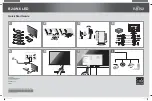
Both wTn1 modules set as Sensor1 (1 beep when switched on) or as Sensor2
(2 beeps when switched on):
✘
+
✘
+
Carrying out the exam
The functionalities below concern the Sw WPulsePen, of which the Sw WPulsePen_LP is a simplified
version.
Select the icon
to start a new exam and choose a patient from those already in the archive or insert
the data of a new patient, such as name, surname, date of birth, gender: at this point the keys
corresponding to the various arteries will be enabled. Selecting the desired one a new screen will open
where the acquired signals will be displayed once the wTn1 probe(s) has(have) been positioned on the
region to be explored. An automatic signal "Freeze" function stops the acquisition when no activity is
detected on the wTn1-Sensor2 tonometer (blue trace). The operator must firmly rest his elbow and hold
the wTn1 probe as shown in fig. 3 with the fingertips in contact with the patient's skin, thus minimizing
tremors. The probe should be held perpendicular to the skin and not tilted. It is advisable to consult the
Quick Guide contained in the Help-Tutorial. With the PulsePenHolder accessory, stable signals are obtained
without the operator's tremor. Once a series of overlapping complexes has been obtained, indicated by the
green color of the traffic light at the top of the screen (see the software Help), the
operator can interrupt the acquisition by lifting the wTn1-Sensor2 tonometer. By
pressing the icon with the disk symbol or the Enter key, the last heart complexes
recorded, up to a maximum of ten, are automatically saved and analyzed. At this
point, a window will appear for entering the systolic and diastolic pressure
measured immediately before, during or after, with an external
sphygmomanometer. In the case of a peripheral Artery, the operator will also have
to use a meter to obtain three distances, in millimeters: Carotid - Peripheral Artery,
Carotid - Suprasternal notch and SupraSternal notch - Peripheral Artery.
In the estimation of PWV this allows to apply both methods of distance evaluation
suggested by the international guidelines, i.e. both the “direct method” and the
“subtractive method” - see the relevant paragraph.
At this point a new panel will show the parameters automatically calculated by the
software.
Refer to the online Help for all the additional features available.
12
User Manual
PulsePen
- V. 5.0_b
fig. 3










































